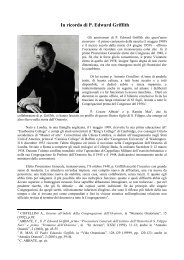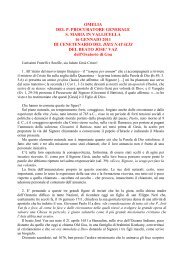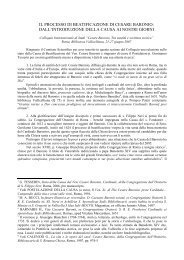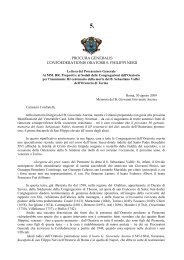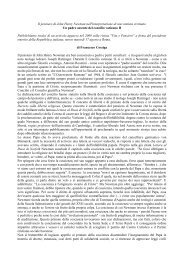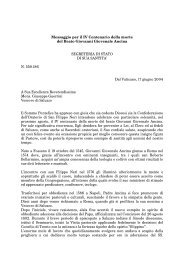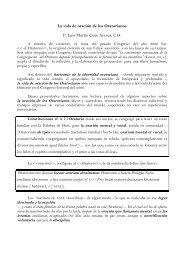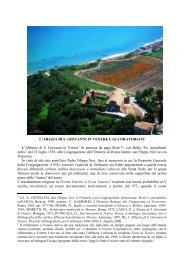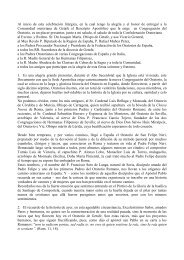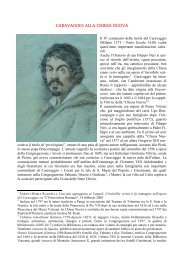Parte I - Confederazione dell'Oratorio di San Filippo Neri
Parte I - Confederazione dell'Oratorio di San Filippo Neri
Parte I - Confederazione dell'Oratorio di San Filippo Neri
Create successful ePaper yourself
Turn your PDF publications into a flip-book with our unique Google optimized e-Paper software.
U.M. Lang, The miracle of St. Philip <strong>Neri</strong> in the Palazzo Massimo97Germanico Fedeli, a Father of the Oratory who was later made canon ofSt Peter’s, knew Paolo well and visited him regularly during his terminal illness.He gave an account of the miracle based on what he had been told byFabrizio Massimo and Violante <strong>San</strong>tacroce. His deposition agrees with theprevious testimonies of the eyewitnesses: he states that the boy had been spirituallyprepared to <strong>di</strong>e, but there is no mention of his confession. 33The Depositions of the Third ProcessThe third process ‘in specie’ was opened on 19 July 1610 before the Au<strong>di</strong>torsof the Rota. No fewer than two hundred and sixty-four witnesses wereheard, most of whom had already testified before. All the witnesses confirmedtheir previous depositions, and some of them added unknown particularsabout the life of the much venerated Father Philip. 34 The first witnessto be (re-)examined in three sessions on 19, 23 and 24 July 1610 was FabrizioMassimo, by then 72 years old. Accor<strong>di</strong>ng to the acts of the process, he<strong>di</strong>d not add new facts or important circumstances. Fabrizio was mainly questionedabout Philip’s raising to life of his son Paolo and repeated in brief hisaccount of the miracle. The inquiry focused on three points: first, how longin Fabrizio’s estimation Paolo had been dead; secondly, whether Paolo hadreally <strong>di</strong>ed in the first place or whether he only showed signs that could bemistaken for death; and, thirdly, why he was raised to life only for a shorttime and then <strong>di</strong>ed again. Fabrizio reckoned that the boy had been dead forabout half an hour. He and the other people present were certain about theboy’s death. The parish priest had already made the recommendation of Paolo’ssoul and had left the house. Moreover, the whole body had already becomecold and the pulse had stopped. 35 As for the third question about the33 ‘Non restando <strong>di</strong> <strong>di</strong>re, che, pochi giorni prima moresse, ragionando io con detto Paolo, gli<strong>di</strong>ssi, se voleva barattare con me, con darmi egli il suo male, con il merito della patienza (che realmentefu male <strong>di</strong> molta pena, et egli lo sopportava con ogni patienza) che io gli havrei data la miasanità; mi rispose, che non si curava <strong>di</strong> barattare, et che stava contento del suo male: onde non èmaraviglia, se <strong>di</strong>sse al beato padre, che moriva volentieri’; Processo , III, 292.34 Cistellini (1989), III, 1948, comments: ‘Col ricordo <strong>di</strong> lui si avvivava quello della foltaschiera dei suoi figli spirituali e <strong>di</strong>scepoli come in un curioso convegno <strong>di</strong> suggestive memorie’,and adds in fn. 50: ‘C’è da chiedersi perché alcuni fra i più noti (il Pateri, il Fedeli e altri), dopoaver già ampiamente deposto in passato, ora si <strong>di</strong>lungavano con nuovi particolar, mentre altri, chenon deposero in passato, nemmeno ora recano la loro testimonianza’.35 ‘Io <strong>di</strong>co, che lo tenni per morto, e quelli che erano presente, lo tennero per morto; il preteessersi già partito, per haverli racomandato l’anima e lasciatolo per morto; e per concorrer tuttil lialtri segni, che concorreno alli morti, con esser rafreddato tutto, da capo a piede, perso il polso, etintesito’, Processo, IV, 20.



